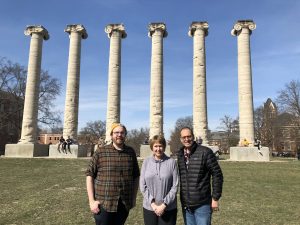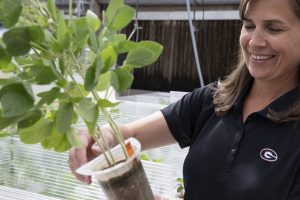A unique collaboration between plant biologists and biochemists is looking to tackle the most financially taxing pathogen in the soybean industry.
Soybean cyst nematode (SCN) is the most detrimental and costly pathogen affecting soybean production in the United States, with more than $1 billion lost annually due to SCN infection. Management of this pathogen relies on the use of SCN-resistant soybean cultivars, a strategy that has struggled in recent years due to nematodes showing resistance to those cultivars.
Researchers at the University of Missouri and the University of Georgia recently published a paper related to an underutilized source of resistance in the soybean genotype Peking. That source is linked to two polymorphisms in serine hydroxyl-methyltransferase 8 (SHMT8). SHMT is an enzyme important for folate-mediated 1-carbon metabolism, a universal metabolic process.

“The results have certainly given us some new insight into how these two amino acids impact the function of the susceptible and the resistant versions of the enzyme,” said Melissa Mitchum, a professor of plant nematology in the Department of Plant Pathology at the University of Georgia, and former professor in the Division of Plant Sciences and Bond Life Sciences Center at MU. Mitchum is also a faculty member in the Institute of Plant Breeding, Genetics and Genomics (IPBGG) at the University of Georgia. “Just two genetic mutations make the plant resistant. We’re trying to figure out how those mutations have altered the enzyme function to confer SCN resistance.
“When the nematode infects, it sets up a feeding cell near the vasculature. What happens in the resistant plant is that the feeding cell degenerates. It basically undergoes a premature cell death response. It’s an active response locally in response to the nematode feeding. It’s very effective against the nematode. In fact, genetic resistance is our No. 1 tool for combatting SCN.”
Mitchum said their collaborative research, which serves as the focus of the published paper, showcases mechanistic insight into how the enzyme is functioning in resistance.
“It looks like the genetic changes have led to the enzyme’s inability to bind to folate, which is a normal cofactor that this type of enzyme requires to function,” Mitchum said. “This likely alters folate metabolism in the feeding cell, and is contributing to the resistance response. Or, it’s gained some unique type of enzymatic activity or function that we don’t know yet.”
Mitchum’s lab published a paper in 2012, while she was at MU, related to the SHMT enzyme and its role in SCN resistance. Mitchum soon partnered with the structural biology group in the Department of Biochemistry at Mizzou to help with the project, supported by a Bond Life Sciences Center seed grant program established to foster interdisciplinary collaborations among MU researchers. That group includes the labs of John Tanner and Lesa Beamer, both professors in the Department of Biochemistry.
“This collaboration started a few years ago, after we published on the SHMT enzyme being involved in SCN resistance,” Mitchum said. “We cloned the gene back in 2012, and we’ve been trying to understand how that gene functions in conferring resistance to the nematode.

“As part of that ongoing research, we partnered with the structural biology group in biochemistry. We wanted to move forward on some of the biochemical aspects of the enzyme’s function, especially in resistance, and that is their expertise.”
David Korasick, a postdoctoral fellow who was part of the Tanner lab and mentored by Tanner, Beamer and Mitchum, produced five crystal structures of different states of the SHMT8 tetramers from the SCN-susceptible and SCN-resistant cultivar. He combined protein biochemistry, protein biophysics and X-ray crystallography approaches to tackle the problem.
“This biochemical study includes one of only a handful of crystal structures of this enzyme in the plant world,” Mitchum said. “For an agricultural plant like soybean, it’s the first. We now have a crystal structure, with both the resistant and susceptible versions. We only had a computational structure previously. On top of that, we can see where those mutations fit. We can see they’re near these cofactor binding domains, and David was able to further demonstrate that the enzyme in at least the resistant version is significantly compromised in binding to folate. This is a big deal because it provides insight into the enzyme’s function.”
“Melissa gave us the vectors and David purified and crystallized the enzyme,” Beamer added. “He took both the SMHT8 from susceptible soybean and the resistant strain soybean and studied both of them. That gave us a large amount of the enzyme in test tubes. We could do a variety of things to compare the two, with side-by-side detailed comparisons.”
Beamer said they looked at the 3D structure of the proteins, using a method called X-ray crystallography.
“That method, by default, requires that you crystallize the protein,” Beamer said. “That gives you information on a detailed molecular structure. David was successful in crystallizing the enzymes. With that crystallization, we are now able to learn, down to the atomic level, information on how the enzyme really works.”
The Peking-type of SCN resistance isn’t a new type of resistance, but is currently available in less than 5 percent of commercially available SCN-resistant cultivars. Mitchum said it would be nice to see it return, because the market is currently dominated by a single type of resistance that is losing effectiveness.
“There is still a lot of potential with this type of resistance,” Mitchum said. “We still don’t truly know the mechanisms of resistance against the nematode. That’s what we’re trying to figure out. Once we figure out how the resistance works, then we can possibly engineer it in a way that makes it more durable. We want to combat these virulent nematodes. We’re working to put this type of resistance back into a farmer’s crop rotation strategy for managing SCN and ultimately modify it in a way that makes it more resistant.”
Along with Mitchum, Tanner, Beamer and Korasick, Pramod Kandoth, a former postdoctoral fellow in the Division of Plant Sciences at MU, was part of the paper. Funding for the research came, in part, from the Missouri Soybean Merchandising Council, a Bond Life Sciences Center Seed Grant and a USDA-NIFA Fellowship to Korasick.
“We’re biochemists, and Melissa is on the plant biology side,” Beamer said. “Coming together, it really was a great opportunity to learn from each other and interact. This work is a good opportunity to bring together two different types of expertise and answer an interesting and important biological question.”